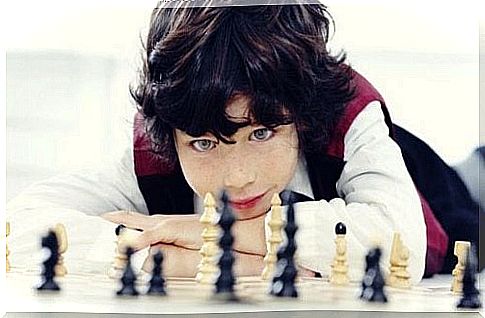The Brain Of A Gifted Child: Benefits And Limitations

The brain of a gifted child has its advantages but also its beg r ensninger. These children process information quickly, have a high analytical capacity and a sophisticated critical eye. However, they do not always reach their potential, or develop a strong mind that is able to handle their abilities or emotional world in a proper way.
What one might initially think is nothing more than a blessing, someone discovers is far from just that. Every gifted child with high capacity will face the same challenges as any girl or boy of the same age, in addition to the challenges that come from his or her high IQ.
So, although we often talk about the different benefits of a brain gifted with extraordinary abilities, we do not always remember the other factors that characterize this segment of the population. Here we are talking about anxiety, low self-esteem, feelings of isolation , disconnection from an environment that takes poor care of their needs… These problems become clearer from children are 11 years old.
It is not enough to just initiate measures to identify these children at an early age. (It is estimated that the ideal age is when they are between 3 and 5 years old). We must also understand the brains of gifted children. It is also very important to understand how they develop and what the most appropriate support mechanisms are for certain neural milestones.

The brain of a gifted child with high ability
Neurologists have always been interested in understanding the brains of gifted children. How are they different from children with average or normal intelligence? What exceptional neural resources do they have? We can answer many of these questions thanks to new advances in technology, such as MRI scans.
These are some of the findings we have at our disposal thanks to organizations such as the British Psychological Society .
The cerebral cortex develops slowly
This data is striking. One thing that is clear thanks to Albert Einstein is that people with elevated IQ do not have larger brains. In addition, we have seen that children with high abilities usually have a narrower cerebral cortex. That said, this layer develops, and thickens slowly but surely, until the children reach adolescence.
In children with a “normal” IQ, the opposite happens. They have a thicker cortex when they are younger. At the age of 12 or 13 years, this area tends to decrease and decrease in size. What does this mean? The brain of a child with elevated abilities becomes more sophisticated and specialized over time. It reaches its greatest potential in adolescence.
Brain regions are specialized
Children with high abilities show greater volume of gray matter in certain brain groups. Remember that gray matter is linked to cognition, intelligence and our ability to process information. This basically means that gifted students have greater abilities to handle data, analysis and draw conclusions.
There are 28 regions in the brain related to our ability to reason, act, focus our attention and respond to external sensory stimuli. Children with high abilities show a specialization in each of these areas.

Greater neuronal connection
While gray mass stores and controls information, white mass moves. It enables connections between neurons. Therefore, this is without a doubt one of the most remarkable features of a gifted child’s brain. It has a high neuron efficiency.
So they have many other neural “highways” and other roads where they can channel data, information and concepts. In addition, these are intercommunication routes. A large sophisticated and hyperconnected network where everything works very, very quickly. This property also has its drawbacks.
Sometimes traffic jams can occur. That is, the child with high abilities may feel overwhelmed by so much processed information, confronted with so many connections between one idea and another. That’s why they can sometimes get stuck with so many ideas, hypotheses and inferences. With so much mental and neuronal activity, they can sometimes fall far behind in an exam or even when answering a seemingly simple question.
Neuroplasticity, the biggest benefit
A large part of the neurologist’s work highlights the great plasticity of a gifted child. As we have shown before, the cerebral cortex grows slowly, specializes, and changes all the time. It creates new connections and new highways in a gradual way to enable learning.
When a child notices a new experience, their brain changes. It specializes and creates new pathways, nerve pathways, to allow areas, regions and structures to communicate. The plasticity of gifted children is so incredible that many neurologists indicate that they are constantly evolving. They are like minds that are so hungry for interaction that we do not always know how to give them the attention they deserve.

To conclude, something that is worth keeping in mind from this analysis is the way the brains of gifted children mature. It becomes gradual but sophisticated, and reaches its peak only in adolescence. Children with normal IQ reach a peak when they are between 5 or 6 years old. However, a gifted child is more demanding at this age.
Above all, they need a favorable environment that allows them to stretch their abilities even further, and accelerate their cerebral plasticity. If a child aged 10 or 11 lives in a structured environment, which does not suit their potential, it is common for them to feel rejected and frustrated. We should be more sensitive to these senses, which are so awake but so fragile in so many ways.









